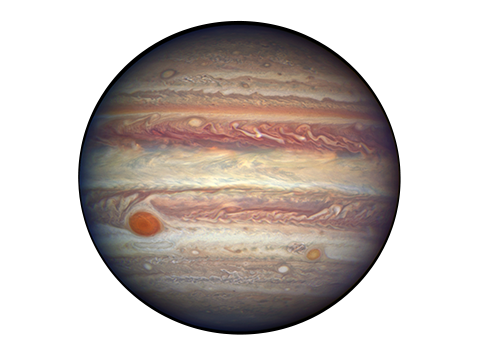Jupiter Facts
Planet Profile
| Type | Gas Giant |
| Age | 4.503 billion years |
| Length of Year | 11.862 Earth year |
| Satellites | 69 (as of 2017) |
| Radius | 43,441 mi |
| Mass | 1.898 × 1027 kg |
| Volume | 1.4313×1015 km3 |
| Orbit Speed | 8.12 mi/s |
| Dist. from Sun | 778 million km, ave |
Below are some of the facts about Jupiter:
- Jupiter is the fifth planet in the solar system, and falls among the gas giants, with a mass of two and a half times of the combined mass of all other planets of the solar system.
- After the sun, moon and Venus, the next brightest object in the solar system is Jupiter. It is visible to the naked eye because of it's size and brightness.
- Jupiter was first sighted and identified by the Babylonians. And then it was named after the Roman God Jupiter, the god of the sky and thunder.
- Jupiter turns or spins every 9 hours 55 mins around its axis. This means it completes one day in this time, which is the shortest day span for a planet in the solar system.
- Jupiter takes 11.8 Earth years to complete one rotation around the sun. This means one Jupiter year is 11.8 Earth years.
- There are cloud belts and zones of crystallized gases and matter in the upper atmosphere of Jupiter. These belts and clouds in the various zones contain crystals of ammonia, sulfur, and mixtures of two compounds.
- The red spot clearly visible in Jupiter is a big high pressure area, where a storm is continuous happening for so many years since 1830. This red spot is 22 degrees south from the equator of Jupiter. In fact it is believed that the storm is raging from even before that recorded date.
- The core of the planet is made of metals, rocks, and compounds of hydrogen.
- The atmosphere of Jupiter is mainly composed of hydrogen and Helium gases in the same proportions as is there in the sun. Below this atmosphere, hydrogen gas is compressed in few layers comprising of a layer of liquid hydrogen, icy core, and metals and rocks.
- Jupiter has large sized moons. The most prominent ones are Ganymeade, Europa, and Callisto Lo. Ganymeade is larger than planet Mercury with a circumference of 5,268 km.
- Jupiter has a prominent ring of dust cloud. As impacts from asteroids and meteors ravaged the planet’s surface, more and more dusts and particles from the planet got added to the ring.
- The Jupiter ring starts from 92,000 km above its atmosphere, and stretches to 225,000 km and beyond as it thins away gradually. The thickness of the ring varies from 2,000 to 12,000 km at places.
- Jupiter has been visited to date by 9 spacecrafts. They are Voyager 1 and 2, Pioneer 10 and 11, Cassini, Galileo, Ulysses, New Horizons, and lastly Juno.
